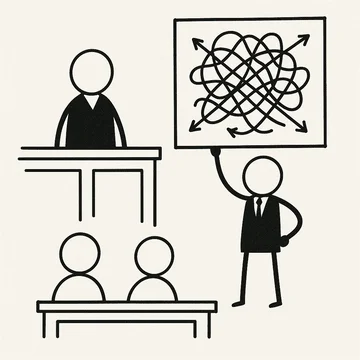
We don't often write about claim construction opinions, because they can be very fact-specific. But Judge Hall's opinion yesterday in Apple Inc. v. Masimo Corporation, C.A. No. 22-1377-JLH (D. Del.) included some generally applicable points worth noting.
Sometimes a Reservation of Rights Actually Works
There's a reason we've all seen countless discovery documents, disclosures, expert reports, and briefs that are larded up with endless reservations of rights: sometimes they work!
This is one of those times. The patentee (Apple) had filed a response to invalidity contentions regarding a design patent in an IPR. In it, Apple described the scope of its patent, but included a reservation stating that it wasn't taking claim construction positions.
In the district court case claim construction briefing, the accused infringer (Masimo) argued that Apple should be held to its descriptions of claim scope which, the accused infringer claimed, contradicted its proposed constructions at the district court.
The Court found otherwise, relying on the patentee's reservations of rights in its filing before the PTO:
The third dispute concerns Masimo’s contention that Apple proposed constructions of the Asserted Design Patents to the Patent Trial and Appeal Board (PTAB) and that Apple should be stuck with what it proposed. Apple says that it did not advance proposed constructions to the PTAB but was merely using words to respond to Masimo’s arguments. I agree with Apple. For one thing, Apple expressly told the PTAB that “Apple’s verbal descriptions are not proposed constructions of the claims of the Asserted Design Patents, nor has Apple intended to modify or specify the scope of the claims of the Asserted Design Patents or to suggest that any claim construction is necessary or appropriate in this case.” . . . Instead, Apple provided a “brief verbal description” of the design elements “in order to explain how the design elements of [each] claimed design contribute to the design’s overall visual impression and how the alleged prior art identified by Masimo differs from [each asserted design patents’] visual impression, as well as its design elements.” . . . Having reviewed the PTAB proceedings cited by Masimo, I don’t think that what Apple said amounts to a clear and unambiguous disclaimer of claim scope.
Apple Inc. v. Masimo Corporation, C.A. No. 22-1377-JLH, D.I. 692 at 8 (D. Del. Oct. 10, 2024).
The Court Sent Design-Patent Indefiniteness to the Jury
As part of its claim construction order, the Court denied the accused infringer's indefiniteness argument, which it had presented both at Markman and at summary judgment. The Court held that the jury would address indefiniteness, because the disputes are factual:
The Federal Circuit has explained that indefiniteness “is amenable to resolution by the jury where the issues are factual in nature.” Bombardier Recreational Prod. Inc. v. Arctic Cat Inc., 785 F. App’x 858, 867 (Fed. Cir. 2019) . . . . The disputes here are material, and they are factual in nature. Accordingly, the Court will deny Masimo’s request for summary judgment and will submit the Dʼ842 and Dʼ936 indefiniteness questions to the jury.
Id. at 10-11. Indefiniteness does not frequently go to the jury, but this is a good reminder that it's an option.
The Court Shuts Down a Late-Disclosed Invalidity Theory Without a Motion to Strike
The accused infringer moved for summary judgment in its favor on an indefiniteness theory it apparently hadn't raised until after opening expert reports.
In response, the patentee's brief included a short waiver argument:
During fact discovery, Masimo never mentioned any invalidity or noninfringement theory related to the D’279 Patent’s eight gray circles. . . . Masimo’s expert, Mr. Delman, did not include any indefiniteness theory related to the circles in his opening invalidity report. . . . He first asserted the circles were claimed in his rebuttal report on noninfringement. . . . In his reply invalidity report, he included a new theory that the D’279 Patent was indefinite because he was confused if the gray circles were claimed. Id. ¶21.
. . .
Masimo litigated this case similarly [to its position at the PTAB], until the end of expert discovery. Its final noninfringement contentions did not mention the gray circles as claimed or missing from the W1. E. . . . Nor did its final invalidity contentions identify the gray circles as claimed, taught by the prior art, or as a basis for indefiniteness. . . . Masimo’s Markman brief, supported by yet another Delman declaration, sought nine separate constructions of each claimed element in the D’279 Patent; the gray circles are not mentioned once. . . . Mr. Delman’s opening invalidity report compared the above-identified elements to the alleged prior art; once again, no mention of gray circles.
D.I. 585. It also accused the expert of lying about when he discovered the issue:
B. Masimo’s feigned confusion does not invalidate Apple’s design patents.
Mr. Delman alleges he first “realized” the gray circles when drafting his noninfringement rebuttal report—nine months after his IPR declaration and after he spent 80 hours reviewing the patents. . . . The motivation behind that “realization” is obvious—Masimo’s IPRs had failed, and it desperately needed a new noninfringement argument. Mr. Delman declared in his rebuttal report: “the high-resolution Figures clearly show that the D’279 Patent claims these concentric circles.” . . . In his invalidity reply report, he asserted (for the first time) that his own flip-flop, due to his previous “confusion” over whether the gray circles were claimed, invalidated the patent. . . . Masimo cannot feign confusion over its own manufactured noninfringement argument to introduce false uncertainty into the patent’s scope.
Id. at 9.
The Court did not explicitly address the allegation of dishonesty—but it did preclude the argument—a complete win for the patentee:
As for Masimo’s request for summary judgment of indefiniteness of the Dʼ279 patent on the ground that it’s unclear whether the Dʼ279 patent claims four concentric circles, Masimo is precluded from pursuing that theory of invalidity because it was not included in its contentions (as required by the scheduling order) or its opening invalidity report.
D.I. 692 at 11. The Court did not require a separate motion to strike, and did not see a need for an involved Pennypack or Rule 16 analysis.
This is something that comes up a fair bit. Parties often attempt to avoid summary judgment by arguing that the other side failed to disclose the relevant argument in response to discovery or in contentions, and it can be a tough call whether to trouble the Court with a separate motion to strike or preclude. This is another data point on that front.
If you enjoyed this post, consider subscribing to receive free e-mail updates about new posts.





